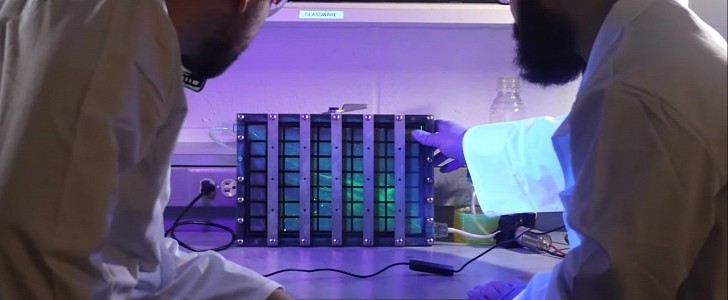While many researchers want to expand the limits of the Li-Ion battery technology, people at Influit Energy work on developing liquid flow batteries. Their latest concept, which is ready to enter commercial production, is advertised as having 23% more energy density than the best Li-Ion batteries of today.
Unlike Li-Ion batteries, liquid flow batteries rely on fluids, called nanoelectrofuels (NEF), to generate electricity. They are nothing new and have been researched for many years. Typically, they involve two chemical liquids that flow over the opposite sides of an ion-exchange membrane to create a flow of electric current. Their energy density is usually low because the battery materials tend to settle at the bottom of the tanks, making the fluids useless.
Influit claims it has solved this problem by using solid nanoparticles of active metal oxide battery material suspended rather than dissolved in the fluid. According to the company, random Brownian movement alone is enough to keep the particles from settling at the bottom of the tanks. The system uses four tanks for spent and unspent fuel and can work in reverse when electricity is applied externally. This essentially means it can act like a rechargeable battery.
Still, the fluids can also be replaced at special dispensers, the equivalent of classic fuel pumps. The dispensers have four nozzles, one for each tank, and can simultaneously drain spent fuels while refilling the fresh ones. The Influit liquid flow battery has an impressive performance, with 23% higher energy density by volume than lithium-ion batteries – that’s somewhere between 350-550 Wh/l at the system level for the Gen1 battery.
Influit is not only developing the fluids, called anolyte and catholyte, but also the fuel-cell-like devices needed to extract the energy from them. The liquid flow battery also needs a fuel management system that keeps the fluids separated and retains the spent fuel for recycling. And, of course, Influit also makes the infrastructure required to swap the spent fuels with fresh ones.
The liquid flow battery has many advantages, besides the higher energy density. Its fuels are non-flammable and non-explosive. If they accidentally mix, nothing happens except a slight temperature rise by a few degrees. The liquid battery is also much cheaper because it does not use rare materials.
But there are still problems to be solved before going into mass production, despite being such a promising technology. One would be the “fuel cells” longevity, which has not been determined. It’s unclear how long they can operate before getting clogged or needing maintenance or parts replacements. We’ll be on the lookout for this technology and hope to see it soon on a production vehicle.
Influit claims it has solved this problem by using solid nanoparticles of active metal oxide battery material suspended rather than dissolved in the fluid. According to the company, random Brownian movement alone is enough to keep the particles from settling at the bottom of the tanks. The system uses four tanks for spent and unspent fuel and can work in reverse when electricity is applied externally. This essentially means it can act like a rechargeable battery.
Still, the fluids can also be replaced at special dispensers, the equivalent of classic fuel pumps. The dispensers have four nozzles, one for each tank, and can simultaneously drain spent fuels while refilling the fresh ones. The Influit liquid flow battery has an impressive performance, with 23% higher energy density by volume than lithium-ion batteries – that’s somewhere between 350-550 Wh/l at the system level for the Gen1 battery.
Influit is not only developing the fluids, called anolyte and catholyte, but also the fuel-cell-like devices needed to extract the energy from them. The liquid flow battery also needs a fuel management system that keeps the fluids separated and retains the spent fuel for recycling. And, of course, Influit also makes the infrastructure required to swap the spent fuels with fresh ones.
The liquid flow battery has many advantages, besides the higher energy density. Its fuels are non-flammable and non-explosive. If they accidentally mix, nothing happens except a slight temperature rise by a few degrees. The liquid battery is also much cheaper because it does not use rare materials.
But there are still problems to be solved before going into mass production, despite being such a promising technology. One would be the “fuel cells” longevity, which has not been determined. It’s unclear how long they can operate before getting clogged or needing maintenance or parts replacements. We’ll be on the lookout for this technology and hope to see it soon on a production vehicle.







